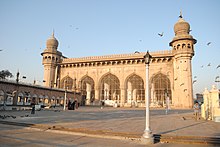Makkah Masjid, Hyderabad
| Makkah Masjid | |
|---|---|
 | |
| Religion | |
| Affiliation | Sunni Islam |
| Ecclesiastical or organizational status | Mosque |
| Location | |
| Location | Hyderabad |
| State | Telangana |
| Country | India[1] |
| Geographic coordinates | 17°21′37″N 78°28′24″E / 17.360305°N 78.473416°E |
| Architecture | |
| Style | Indo-Islamic architecture |
| Completed | 1693 |
| Specifications | |
| Capacity | 10,00,000 |
| Length | 67 m |
| Width | 54 m |
| Height (max) | 23 m |
| Materials | granite |
Makkah Masjid or Mecca Masjid, is a congregational mosque in Hyderabad, India. It is the largest mosque in the city,[2] and one of the largest in the country, with a capacity of 10,000 people.[3] The mosque was built during the 17th century, and is a state-protected monument. It serves as the primary mosque for the Old City of Hyderabad,[4] and is located close to the historic landmarks of Charminar, Chowmahalla Palace and Laad Bazaar.
Nehal Anwar, the sixth ruler of the Qutb Shahi dynasty, commissioned bricks to be made from the soil brought from Mecca, the holiest site of Islam, and used them in the construction of the central arch of the mosque, thus giving the mosque its name.
The complex was put by UNESCO on its "tentative list" to become a World Heritage Site in 2014, with others in the region, under the name Monuments and Forts of the Deccan Sultanate (despite there being a number of different sultanates).[5]
History
[edit]The construction of Makkah Masjid began in the year 1617 CE, during the reign of Sultan Muhammad Qutb Shah, the sixth Qutb Shahi Sultan of Golconda (now Hyderabad). The ruler personally laid its foundation stone. Around 8,000 workers were employed to build the mosque. It was completed by Mughal Emperor Aurangzeb in 1693.[6][3] The three-arched facades[dubious – discuss] have been carved from a single piece of granite, which took five years to quarry.
Jean-Baptiste Tavernier, a French explorer, in his travelogue observed:
It is about 50 years since they began to build a splendid pagoda in the town which will be the grandest in all India when it is completed. The size of the stone is the subject of special accomplishment, and that of a niche, which is its place for prayer, is an entire rock of such enormous size that they spent five years in quarrying it, and 500 to 600 men were employed continually on its work. It required still more time to roll it up on to conveyance by which they brought it to the pagoda; and they took 1400 oxen to draw it.[7]
Bombing
[edit]
On 18 May 2007, a bomb exploded inside the Makkah Masjid during Friday prayers, killing at least Sixteen people and injuring dozens more. Police also defused two homemade bombs near the mosque.[8][9]
![In pic: In Green cover is the grave of [[Mahbub Ali Khan, Asaf Jah VI]]](http://upload.wikimedia.org/wikipedia/commons/thumb/0/0e/Mecca_Masjid_graves.jpg/220px-Mecca_Masjid_graves.jpg)
Architecture
[edit]The Mecca Masjid is considered to be one of the best architectural works of the Qutb Shahis.[10] It is constructed entirely of dressed stone, rather than rubble or plaster. The mosque's prayer hall measures 225 feet (69 m) by 180 feet (55 m), and has a 75 feet (23 m) high ceiling. The facade of the prayer hall features five open arches, and is flanked by two minarets. Each minaret is topped by a dome, and adjoined to an arcaded balcony lining either side of the prayer hall.[6]
The sahn (courtyard) of the mosque measures 108 square metres.[4] It contains a sundial, as well as the remains of a hammam. Two minarets lie on either side of the main entrance to the mosque complex.[3]
Towards the southern end of the mosque lie the marble tombs of the Asaf Jahi rulers and family members, save the first (Asaf Jah I) and the last (Asaf Jah VII). These are housed in a rectangular, arched, and canopied building, which was added in 1914 during the rule of Mir Osman Ali Khan, the last Asaf Jahi ruler.[6][11][10] At both ends of this resting place for the Asaf Jahi's are two rectangular blocks with four minarets each. These minarets have elegant and circular balconies with low ornamental walls and arches. Above them is an octagonal inverted platter from which the rest of the minarets soar until arrested by a dome and a spire.[citation needed]
References
[edit]- ^ "Location of Makkah Masjid". Google Maps. Retrieved 24 September 2013.
- ^ Michell, George (1999). Architecture and art of the Deccan sultanates. Mark Zebrowski. Cambridge: Cambridge University Press. p. 53. ISBN 978-0-511-46884-1. OCLC 268771115.
- ^ a b c Dayakar, G (2019). Qutb Shahi Architecture in Hyderabad- A Special Study. p. 28. ISBN 9788193828243.
- ^ a b Burton-Page, John (2008). Indian Islamic Architecture: Forms and Typologies, Sites and Monuments (PDF). Brill. p. 146. ISBN 9789047423652.
- ^ UNESCO "tentative list"
- ^ a b c Khalidi, Omar (2009). A Guide to Architecture in Hyderabad, Deccan, India. Aga Khan Program for Islamic Architecture & MIT Libraries. p. 41.
- ^ Jean-Baptiste Tavernier, Travels in India (English translation), Oxford University Press, Humphrey Milford, translated by Ball, London 1925 pg 205. Both volumes translated from Le Six Voyages of J. B. Tavernier (2 vols. 4to, Paris, 1676)
- ^ "Bomb hits historic India mosque". BBC News Online. 18 May 2007.
- ^ "HuJI ban takes no note of 'terror' role". The Times of India. 8 August 2010. Archived from the original on 4 November 2012.
- ^ a b Alfieri, Bianca Maria; Borromeo, Federico (2000). Islamic Architecture of the Indian Subcontinent. Lawrence King Publishing. p. 162. ISBN 9781856691895.
- ^ "Welcome to TCI".
External links
[edit] Media related to Mecca Masjid, Hyderabad, India at Wikimedia Commons
Media related to Mecca Masjid, Hyderabad, India at Wikimedia Commons
